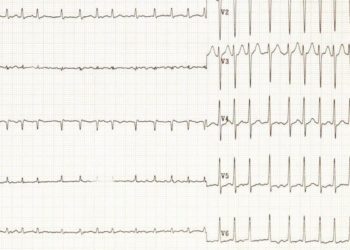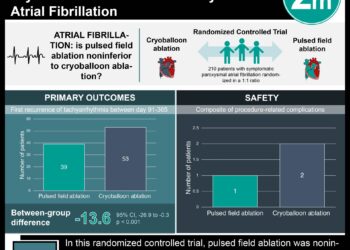The HAS-BLED score: Bleeding risk in atrial fibrillation [Classics Series]
Image: PD
1. The HAS-BLED score is an easy to remember and easy to apply tool that has good predictive accuracy for the risk of major bleeding in patients with atrial fibrillation
2. Since its publication, the HAS-BLED score has been validated in a large cohort study of 7,329 patients
Original Date of Publication: November 2010
Study Rundown: In atrial fibrillation, it is thought that impaired atrial contraction leads to blood stasis within the atria, thereby increasing the risk of thrombus formation and cardioembolic stroke. The CHADS2 score is a risk stratification tool that was developed to identify patients with atrial fibrillation who are at higher risk of stroke and who should therefore be treated with oral anticoagulation. Treatment with oral anticoagulants, however, increases one’s risk of bleeding. The HAS-BLED score was developed in response to the need for tools to estimate the risk of major bleeding in patients with atrial fibrillation. Originally published in 2010, the score consists of 7 factors: hypertension, abnormal renal/liver function, stroke, bleeding history or predisposition, labile INR, elderly (>65 years), and drugs/alcohol use concomitantly. This study demonstrated that the HAS-BLED score had good predictive accuracy for major bleeding in the overall cohort of patients (C statistic 0.72; 95%CI 0.65-0.79), but performed much better in patients on antiplatelet agents (C statistic 0.91; 95%CI 0.83-1.00) or no antithrombotic therapy (C statistic 0.85; 95%CI 0.00-1.00). While its performance was very similar to that of the HEMOR2RHAGES scheme, the HAS-BLED score is much easier to remember and use, as it consists of fewer factors and only requires clinical assessment or routine bloodwork. The HAS-BLED score has since been validated in a larger cohort study published in the Journal of the American College of Cardiology.
In-Depth [retrospective cohort study]: This study was originally published in 2010 in Chest. It utilized a cohort of patients that were identified from the prospectively developed Euro Heart Survey on Atrial Fibrillation database. Patients in the database were followed for one-year to determine survival and incidence of major adverse events, including major bleeding (i.e., hemoglobin drop >2 g/L or requiring transfusion). The HAS-BLED score was constructed by identifying bleeding risk factors from a derivation cohort, and adding consistent risk factors for major bleeding found in recent systematic reviews. The final score included hypertension (systolic >160 mmHg), abnormal renal (dialysis, renal transplantation, or creatinine≥200 umol/L) or liver function (chronic liver disease, or biochemical evidence), stroke, bleeding history or predisposition, labile INR (therapeutic time in range <60%), elderly (>65 years), drugs/alcohol use concomitantly.
Of the 5,272 patients in the Euro Heart Survey on Atrial Fibrillation, 3,456 did not have mitral valve stenosis or valvular surgery and were included in this study. The HAS-BLED score was compared with the HEMOR2RHAGES scheme, a previously developed tool for estimating the risk of bleeding. C statistics were calculated to determine the predictive accuracy of each model using various sets of patients. The HAS-BLED score had C statistics of 0.72 (95%CI 0.65-0.79) for the overall cohort, 0.69 (95%CI 0.59-0.80) for patients on oral anticoagulants, 0.91 for patients on antiplatelet agents (95%CI 0.83-1.00), and 0.85 for patients on no antithrombotic therapy (95%CI 0.00-1.00). The HEMOR2RHAGES scheme had C statistics of 0.66 (95%CI 0.57-0.74) for the overall cohort, 0.64 (95%CI 0.53-0.75) for patients on oral anticoagulants , 0.83 for patients on antiplatelet agents (95%CI 0.68-0.98), and 0.81 for patients on no antithrombotic therapy (95%CI 0.00-1.00).
|
Clinical characteristic |
Points awarded |
| Hypertension |
1 |
| Abnormal renal and liver function (1 each) |
1 or 2 |
| Stroke |
1 |
| Bleeding history or predisposition |
1 |
| Labile INR |
1 |
| Elderly (>65 years) |
1 |
| Drugs or alcohol (1 each) |
1 or 2 |
|
HAS-BLED score |
Number of patients |
Bleeds per 100 patient-years |
|
0 |
798 |
1.13 |
|
1 |
1,286 |
1.02 |
|
2 |
744 |
1.88 |
|
3 |
187 |
3.74 |
|
4 |
46 |
8.70 |
|
5 |
8 |
12.50 |
|
6 |
2 |
0.0 |
|
7 |
0 |
– |
|
8 |
0 |
– |
|
9 |
0 |
– |
By Andrew Cheung, M.D.
© 2013 2minutemedicine.com. All rights reserved. No works may be reproduced without expressed written consent from 2minutemedicine.com. Disclaimer: We present factual information directly from peer reviewed medical journals. No post should be construed as medical advice and is not intended as such by the authors, editors, staff or by 2minutemedicine.com. PLEASE SEE A HEALTHCARE PROVIDER IN YOUR AREA IF YOU SEEK MEDICAL ADVICE OF ANY SORT.






